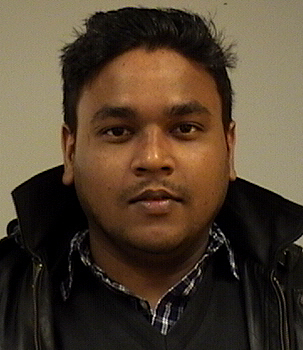NSF PLR 1847173 – CAREER: Fracture Mechanics of Antarctic Ice Shelves and Glaciers – Representing Iceberg Calving in Ice Sheet Models and Developing Cyberlearning Tools for Outreach
Overview
Iceberg calving is a complex natural fracture process and a dominant cause of mass loss from the floating ice shelves on the margins of the Antarctic ice sheet. There is concern that rapid changes at these ice shelves can destabilize parts of the ice sheet and accelerate their contribution to sea-level rise. The goal of this project is to understand and simulate the fracture mechanics of calving and to develop physically-consistent calving schemes for ice-sheet models. This would enable more reliable estimation of Antarctic mass loss by reducing the uncertainty in projections. The two research aims are to:
(1) investigate crevasse propagation in viscous glacier ice using conduct full-Stokes fracture mechanics models; and
(2) develop fracture-physics-based calving schemes for depth-integrated, higher-order Stokes flow approximations in ice sheet models.
This project aims to provide fundamental understanding of iceberg calving by advancing the frontiers in computational fracture mechanics and nonlinear continuum mechanics and translating it to glaciology. The project investigates crevasse propagation using poro-damage mechanics models for hydrofracture that are consistent with nonlinear viscous ice rheology, along with the thermodynamics of refreezing in narrow crevasses at meter length scales. It will develop a fracture-physics based scheme to better represent calving in ice-sheet models using a multiscale method. The effort will also address research questions related to calving behavior of floating ice shelves and glaciers, with the goal of enabling more reliable prediction of calving fronts in whole-Antarctic ice-sheet simulations over decadal-to-millennial time scales.
The research plan is integrated with an education and outreach plan that aims to (1) enhance computational modeling skills of engineering and Earth science students through a cross-college course and a high-performance computing workshop and (2) increase participation and diversity in engineering and sciences by providing interdisciplinary research opportunities to undergraduates and by deploying new cyberlearning tools to engage local K-12 students in the Metro Nashville Public Schools in computational science and engineering, and glaciology.
Publications
- Duddu, R., Jimenez, S., & Bassis, J. N. (2020). A nonlocal continuum poro-damage mechanics model for hydrofracturing of surface crevasses in grounded glaciers. Journal of Glaciology, 66(257): 415-429, 2020. doi: 10.1017/jog.2020.16 (link)
- Sun, X., Duddu, R., and Hirshikesh (2021). A poro-damage phase field model for hydrofracturing of glacier crevasses. Extreme Mechanics Letters, 2021. doi:10.1016/j.eml.2021.101277 (link)
- Huth, A., Duddu, R. & Smith, B. E. (2021a). A generalized interpolation material point method for shallow ice shelves. 1: Shallow shelf approximation and ice thickness evolution. Journal of Advances in Modeling of Earth Systems, 13(8), e2020MS002277. doi: 10.1029/2020MS002277 (link)
- Huth, A., Duddu, R. & Smith, B. E. (2021b). A generalized interpolation material point method for shallow ice shelves. 2: Anisotropic nonlocal damage mechanics and rift propagation. Journal of Advances in Modeling of Earth Systems, 13(8), e2020MS002292. doi: 10.1029/2020MS002292 (link)
- Clayton, T., Duddu, R., Siegert, M. & Martínez-Pañeda, E. (2022) A stress-based poro-damage phase field model for hydrofracturing of creeping glaciers and ice shelves. Engineering Fracture Mechanics, 272, 108693. doi: 10.1016/j.engfracmech.2022.108693 (link)
- Gao, Y, Ghosh, G., Jimenez, S., & Duddu, R. (2023). A finite-element-based cohesive zone model of water-filled surface crevasse propagation in floating ice tongues. IEEE Computing in Science & Engineering, 25(3): 8–16. doi: 10.1109/MCSE.2023.3315661 (link)
- Bird, R. E., Augarde, C. E., Coombs, W. M., Duddu, R., Giani, S., Huynh, P. T. & Sims, B. (2023). An hp-adaptive discontinuous Galerkin method for phase field fracture. Computer Methods in Applied Mechanics and Engineering, 416, 116336. doi: 10.1016/j.cma.2023.116336 (link)
- Huth A., Duddu, R., Smith, B. & Sergienko, O. (2023). Simulating the processes controlling ice-shelf rift paths using damage mechanics. Journal of Glaciology, 69(278), 1915-1928. doi: 10.1017/jog.2023.71 (link)
- Clayton, T., Duddu, R., Hageman, T. & Martínez-Pañeda, E. (2024). The influence of firn layer material properties on surface crevasse propagation in glaciers and ice shelves. The Cryosphere, 18, 5573–5593. doi: 10.5194/tc-18-5573-2024 (link)
- Hageman, T., Mejía, J., Duddu, R., & Martínez-Pañeda, E. (2024). Ice viscosity governs hydraulic fracture that causes rapid drainage of supraglacial lakes. The Cryosphere, 18(9), 3991-4009. doi: 10.5194/tc-18-3991-2024 (link)
- Gupta, A., Nguyen, D. T., Hirshikesh & Duddu, R. (2024). Damage mechanics challenge: Predictions from an adaptive finite element implementation of the stress-based phase-field fracture model. Engineering Fracture Mechanics, 306, 110252. doi: 10.1016/j.engfracmech.2024.110252 (link)
- Navidtehrani, Y., Duddu, R. & Martínez-Pañeda, E. (2024). Damage Mechanics Challenge: Predictions based on the phase field fracture model. Engineering Fracture Mechanics, 301, 110046. doi: 10.1016/j.engfracmech.2024.110046 (link)
- Bassis, J.N., Crawford, A., Kachuck, S.B., Benn, D.I., Walker, C., Millstein, J., Duddu, R., Astrom, J., Fricker, H. & Luckman, A. (2024). Stability of Ice Shelves and Ice Cliffs in a Changing Climate. Annual Review of Earth and Planetary Sciences, 52. doi: 10.1146/annurev-earth-040522-122817 (link)
- Nguyen, D. T., Gupta, A., Duddu, R. and Annavarapu, C. (2025). An adaptive mesh refinement algorithm for stress-based phase field fracture models for heterogeneous media: Application using FEniCS to ice-rock cliff failures. Finite Elements in Analysis and Design, 244, 104311. doi: 10.1016/j.finel.2024.104311 (link)
- Ranganathan, M., Robel, A. A., Huth, A., and Duddu, R. (2025). Glacier damage evolution over ice flow timescales. The Cryosphere, 19, 1599–1619. doi: 10.5194/tc-19-1599-2025 (link)
- Clayton, T., Duddu, R., Hageman, T. and Martínez-Pañeda, E. (2025). Modeling ice cliff stability using a new Mohr-Coulomb-based phase field fracture model. Journal of Glaciology, 1-34, doi: 10.1017/jog.2025.21 (link)
- Karuthedath, P. L., Gupta, A., Mamindlapelly, B., Chowdhury, R., & Duddu, R. (2025). A generalized framework towards continuity and computational efficiency in topology optimization using multi-patch isogeometric methods. Engineering with Computers, 1-50. doi: 10.1007/s00366-025-02133-z (link)
- Saurabh, S., Gupta, A., Chowdhury, R., & Duddu, R. (2025). Robust topology optimization for uncertainty in load positions of transient dynamic loading. Reliability Engineering \& System Safety, 264(PB): 111440. doi: 10.1016/j.ress.2025.111440 (link)
- Sutcliffe, S. J., Coombs, W. M., Zhang, W., Duddu, R., & Augarde, C. E. (2026). Modelling cliff collapse and run-out with the material point method. Computers and Geotechnics, 189, 107608. doi: 10.1016/j.compgeo.2025.107608 (link)
Conference/Workshop Presentations
- Huth, A., Smith, B. E., and Duddu, R. Modeling ice shelf weakening with the material point method and damage mechanics. American Geophysical Union, Fall Meeting 2018, Abstract #C34A-02, Washington, D.C., December 10 – 14, 2018.
- Duddu, R., Jimenez, S., and Bassis, J. N. A comparison of fracture-physics-based calving models including hydrofracturing. American Geophysical Union, Fall Meeting 2018, Abstract #C31C-1547, Washington, D.C., December 10 – 14, 2018.
- Duddu, R. Modeling tensile and shear fracture in ice using damage mechanics. Community Earth System Model (CESM) Annual Workshop, National Center for Atmospheric Research, Boulder, CO, June 17 – 19, 2019.
- V. K. Devendiran and R. Duddu. “An appropriate crack driving force function for the phase field approach to model mixed-mode brittle fracture.” ASCE EMI 2019 Conference, Pasadena, CA, June 18 – June 21, 2019.
- Duddu, R., Jimenez, S., Huth, A., and Bassis, J. N. A poro-damage approach to simulating hydrofracture of glaciers and ice shelves. West Antarctic Ice Sheet (WAIS) Workshop 2019, Camp Cedar Glen, Julian, CA, October 16 – 18, 2019.
- Huth, A., Duddu, R., and Smith, B. E. A generalized interpolation material point (GIMP) method for shallow shelf approximation of ice flow. Community Earth System Model (CESM) Annual Workshop, National Center for Atmospheric Research, Boulder, CO, February 10 – 12, 2020.
Seminar Talks
- Simulating rift propagation in Antarctic ice shelves using nonlocal continuum damage mechanics, Marine Geology and Geophysics Group, Lamont Doherty Earth Observatory, Columbia University, New York, NY, October 14, 2020.
- Modeling Fracture Propagation in Marine-Terminating Glaciers and Ice Shelves Using Continuum Damage Mechanics. Biweekly Solid Earth and Planetary Physics Seminar (BISEPPS), Harvard University, Cambridge, MA, July 1, 2020.
- Modeling crevasse propagation in glaciers due to hydromechanical fracture. Georgia Institute of Technology, Atlanta, GA, August 22, 2019.
Students
 |
Vignesh Kumar DevendiranM. S. student, Graduated: May 2019 (Non-thesis) Research project: Modeling mixed-mode fracture in ice under biaxial compression in using phase field damage models |
 |
Ashvin OliPh. D. student, Expected Graduation: May 2028 Research project: Stokes-based phase field fracture model for crevasse propagation in creeping glaciers. |
Postdocs
 |
HirshikeshPh. D., Indian Institute of Technology Madras Research project: A poro-damage phase field model for hydraulic fracturing of glacier crevasses. |
 |
Abhinav GuptaPh. D., Indian Institute of Technology Roorkee Research project: Adaptive phase field modeling of glacier and ice shelf fracture using FEniCS. |



©2026 Vanderbilt University ·
Site Development: University Web Communications